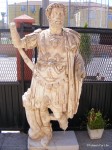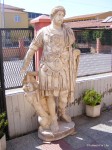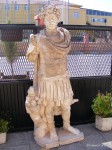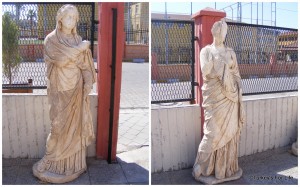Archaeologists excavating the ancient Lycian city of Tlos on the Mediterranean in southwestern Turkey have uncovered five almost intact Roman-era marble statues. Three of them are of Roman emperors Hadrian, Antonius Pius and Marcus Aurelius. The two are of women, one probably Faustina Minor, daughter of Antonius Pius and wife of Marcus Aurelius, and the other of a goddess, possibly Isis. They are missing some hands and arms, and the statue of the goddess has no face, but other than that they are whole and unbroken, a very rare thing indeed.
While I was looking for more detailed pictures of the find, I encountered this blog entry, both charming and unnerving, written by someone on the scene. They read about the find in the above article.
We assumed the statues would be whisked away to Istanbul, Ankara or at best, Antalya Archaeological Museum – but, thanks to Twitter, we saw one of the Turkish language newspapers had reported the statues had been taken to Fethiye Museum. Often overlooked by visitors to Fethiye, the museum finally has in its possession a bit of a draw in the recently discovered statues.
We went up there yesterday to see if we could see them, expecting them to be packed away somewhere, not for public viewing just yet. But, maybe we got there at the perfect time and the museum hasn’t decided what to do with the statues yet because there they were, greeting us at the gate.
They’re just hanging out there. Right inside a gate a 5-year-old could scale easily. It’s fantastic that locals have such access to their ancient heritage, but security-wise and conservation-wise, they should probably be indoors somewhere behind lock and key. I’m sure (okay, I’m not, but I hope) they’ll be moved soon. Meanwhile, we get the benefit of these great pictures.




Tlos is thought to be the most ancient and largest of Lycian cities. In Greek mythology, the hero Bellerophon, grandson of Sisyphyus, slayer of the Chimera, lived in Tlos along with his famed flying steed Pegasus. The Romans dubbed it “the most splendid metropolis of the Lycian nation” and it’s one of the few Lycian cities to have remained inhabited through the Byzantine and Ottoman periods. The remains of an Ottoman fortress perched on a hill above the ancient acropolis were used into the 19th century, most notoriously by local chieftain/brigand/king of thieves Kanli Ali Aga, aka Bloody Ali.
The excavation that unearthed the statues has found evidence of Tlos’ past going back 10,500.